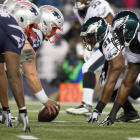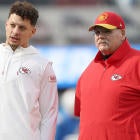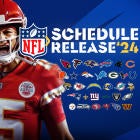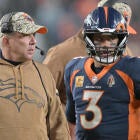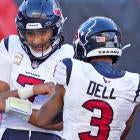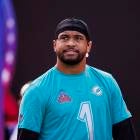There isn't a right or wrong way to allocate resources in putting together a team that has Super Bowl potential. In fact, you could call it "different strokes for different folks."
The Falcons made it to Super Bowl LI with quarterback Matt Ryan having the NFL's third-highest 2016 cap number. The 2013 Seahawks rode a dominant defense to a decisive Super Bowl XLVIII victory when most of the Legion of Boom, Seattle's vaunted secondary, was still on extremely affordable rookie contracts. Seahawks quarterback Russell Wilson was the best bargain in the NFL since he was a third round pick in the 2012 draft making less than $550,000.
The following graphic outlines the salary cap charges for the Eagles and Patriots' key contributors at each position and on special teams. It works out to 31 players on offense and defense for each team. The Eagles have 15 offensive players and 16 defensive players while the split is reversed for the Patriots.
Reserve list and dead money charges are tracked as well. With any player whose playing time was at least 35 percent, only the weeks he wasn't on the 53-man roster are classified as a reserve list salary cap charge. Otherwise, a player's entire cap hit goes under the reserve list category.
For example, Eagles quarterback Carson Wentz went on injured reserve 15 weeks into the regular season with a serious injury to his left knee. That means 3/17ths of Wentz's $6,069,684 2017 cap number, which is $1,071,121, has been attributed to the reserve list, while the $4,998,563 balance goes under his position. This type of calculation was also made for Eagles left tackle Jason Peters and Patriots right tackle Marcus Cannon.
Dead money is a salary cap charge for a player that is no longer on a team's roster. The Collective Bargaining Agreement's $210 daily amount for participating in a team's voluntary offseason workout program is included in the cap numbers.

Each NFL team's actual salary cap (known as adjusted salary cap) is typically different from the NFL's set amount because unused cap room can be carried over from one year to the next year and other adjustments can further increase or decrease cap space. The actual salary cap is currently $167 million.
The Eagles are operating with a bigger adjusted salary cap thanks to more of a rollover from the 2016 league year. The achievement of not-likely-to-be-earned incentives that had to be accounted for nearly wiped out New England's unused cap room. Philadelphia's adjusted salary cap is just under $177 million. New England's is a little less than $168.2 million.
Philadelphia has an even distribution with $60.59 million devoted to offense and $60.67 million on defense. New England's cap spending is weighted toward the offense with almost $2 million more than Philadelphia. The breakdown is $62.287 million for offensive and $43.639 million on defense.
Find out what SportsLine's advanced computer model has to say about the final score of Super Bowl LII.
Now let's break it down by position.
Offense
Quarterback
A high quality quarterback on a rookie contract, like Wentz, is the best value in the NFL because of the roster flexibility provided. Wentz, 2016's second overall pick, was in the driver's seat for league MVP before tearing multiple ligaments in his left knee during Week 14 against the Rams. Eagles owner Jeff Lurie referred to the two-year, $11 million contract (worth up to $22 million with salary escalators and incentives) given to Nick Foles to upgrade the backup position as money well spent earlier in the week.
Tom Brady's $14 million 2017 cap hit is middle of the pack for a starting quarterback. His willingness to sign below market contracts for the good of the Patriots has paid dividends on the football field. The Patriots have been able to assemble a more talented roster than otherwise possible. Brady was won two more Super Bowl rings since starting this process in 2013. Other upper echelon quarterbacks haven't followed Brady's lead by taking a discount.
Running back
The Eagles have a minimal investment in running backs. Jay Ajayi was acquired from the Dolphins at the trading deadline for a 2018 fourth-round pick after falling out favor in Miami. The 2015 fifth-round pick's cap charge for Philadelphia this season is a shade over $325,000.
LeGarrette Blount didn't find a home until several days after the 2017 draft. He signed a one-year, $1.25 million deal with the Eagles containing additional $1.55 million in incentives. The possibility he'd remain in New England was put in jeopardy when Rex Burkhead received a one-year, $3.15 million deal in free agency because of his dual threat capabilities. Signing restricted free agent Mike Gillislee to a front-loaded two-year, $6.4 million offer sheet that the Bills didn't match made Blount expendable.
The newcomers have taken a back seat in New England despite combined 2017 salaries of $7.15 million. The Patriots haven't gotten a good return on their investment in the duo. Dion Lewis emerged from a crowded backfield to become New England's primary ball-carrier down the stretch of the season at a fraction of the cost. He's in the final year of a two-year, $3 million extension he signed in 2015. James White, who is primarily used as a receiver out of the backfield, is New England's highest-paid running back. He was given in a three-year extension last April averaging $4 million per year.
New England utilizes a fullback more than practically every other NFL team. James Develin received the second most playing time among the league's fullbacks. He was on the field for 30.2 percent of New England's offensive snaps. The two-year contract the signed last offseason is less than Lewis' deal.
Wide receiver
The Eagles remade their receiving corps by signing both Alshon Jeffery and Torrey Smith in free agency. Jordan Matthews, who led Philadelphia wideouts in receptions and receiving yards in 2016, was dealt to the Bills during the preseason. Jeffery won the $9.5 million bet he made on himself on his one-year deal (worth up to $14 million through incentives). The Eagles gave Jeffery, who has Philadelphia's largest cap number at $11.2 million, a four-year, $52 million extension late in the season.
New England has never been a team under head coach Bill Belichick to make a big financial commitment to wide receivers. The only wide receiver to average at least $9 million per year on a long term deal has been Randy Moss nearly a decade ago. The Patriots have gotten their money's worth from the trade with the Saints that brought over Brandin Cooks and a 2017 fourth-round pick for 2017 first- (32nd overall) and third-round picks. Cooks had his third straight 1,000 receiving yard season as one of the NFL's better deep threats while only making a little over $1.5 million, but his salary takes a big jump next season with a fifth-year option for $8.459 million.
Tight end
Backup Brent Celek has a bigger 2017 cap number ($4,006,880) than Zach Ertz ($3,126,880). The first-time Pro Bowler's 2017 cap number was originally $5.6 million before restructuring to create cap room.
The Patriots finally addressed Rob Gronkowski's perpetual unhappiness with the six-year, $54 million extension he signed in 2012 to become the NFL's highest paid tight end by average yearly salary. $5.5 million of not-likely-to-be-earned incentives were added to Gronkowski's contract and are reflected in the numbers at the top of this feature. He earned the entire amount when he was named first-team All-Pro by the Associated Press.
Belichick traded a 2017 fourth-round pick to the Colts for tight end Dwayne Allen, whose 2017 cap number is just over $5 million, and a 2017 sixth-round pick. The Patriots assumed the final three years of Allen's contract worth $17.4 million in the trade. Integrating Allen into the passing game has been difficult.
Offensive line
Philadelphia subscribes to the view that football starts in the trenches. A little over 45 percent of Philadelphia's offensive cap charges are devoted to the offensive line.
It's money well spent. Pro Football Focus recently tabbed Philadelphia's offensive line as the best in the NFL. Lane Johnson is easily the NFL's highest-paid right tackle with the five-year, $56.25 million extension (worth up to $60 million through salary escalators) containing $35.5 million of guarantees he signed in 2016. He has the second biggest 2017 cap number for a right tackle at $9,755,961.
Surprisingly, it took a while for New England's offensive line to jell despite returning the same unit from last season. Brady was sacked almost as many times during New England's first five games this season as in the 12 he played last regular season. Nate Solder has the fifth biggest cap hit for a left tackle at $11,204,763.
The Patriots were smart to lock up center David Andrews shortly after he became eligible for a contract extension. He signed a three-year, $9 million extension (worth up to $11.1 million through incentives). The 2015 undrafted free agent has emerged as one of the NFL's better centers this season. Since Andrews wasn't drafted, the Patriots were probably going to give him a second-round restricted free agent tender in 2018, which will be approaching $3 million, if he had played out his rookie contract. He essentially gave up two unrestricted free agents for a total base value of $6 million. This season, Andrews outperformed Jaguars center Brandon Linder and Seahawks center Justin Britt, both 2014 draft picks who signed extensions averaging $10.34 million and $9 million per year during the preseason.
Defense
Defensive end
The Eagles' philosophy of starting in the trenches also extends to the defensive line. Philadelphia may have the NFL's best depth with edge rushers. $1.5 million of performance bonuses were added during the preseason to the four-year, $26 million contract Brandon Graham signed as an unrestricted free agent in 2015, which has left him underpaid. Graham had a career high 9.5 sacks this season. A $250,000 incentive was earned and a raised his 2018 base salary from $6.5 million to $6.75 million when he got his seventh sack. Reaching nine sacks brought Graham's incentive total to $500,000. Graham's 2018 base salary increased another $250,000 to $7 million.
The Patriots have nominal cap charges for defensive ends. Eric Lee was a late season pickup off the Bills' practice squad. Trey Flowers and Deatrich Wise are on rookie contracts.
Defensive tackle
The Eagles have a huge investment in interior defensive linemen. Fletcher Cox is the NFL's fourth highest-paid defensive player (by average yearly salary). He signed a six-year, $102.6 million extension in 2016 with $63.299 million of guarantees. Acquiring Timmy Jernigan from the Ravens a few weeks before the 2017 draft was an understated move. He's been an upgrade over Bennie Logan, who took a one-year deal from the Chiefs in free agency. Jernigan signed a four-year, $48 million extension with just under $25.5 million in guarantees during the middle of the season.
The Patriots' cap charges on the interior pale in comparison to the Eagles but are significantly more than for their edge rushers.
Linebacker
Eagles linebacker Mychal Kendricks' $6.6 million cap hit is over three times more than the Patriots' collective linebacker cap charges. It would be different story if Patriots Pro Bowler Dont'a Hightower hadn't been limited to five games because of a torn pectoral muscle.
Cornerback
The Patriots made a rare high-priced free agent signing in getting cornerback Stephon Gilmore from the Bills. Gilmore signed a five-year, $65 million contract containing $40 million in guarantees. He got the money cornerback Malcolm Butler, who is an impending unrestricted free agent, wanted from the Patriots. The Super Bowl is probably Butler's last game with the Patriots since Belichick investing heavily in two cornerbacks seems like a remote possibility.
Patrick Robinson exceeded the Eagles' expectations after signing a one-year deal at his $775,000 league minimum salary following an injury-plagued 2016 season that led to the Colts releasing him. Robinson's 50-yard interception return for a touchdown jump-started the Eagles in a 38-7 NFC Championship Game rout of the Vikings. There was some concern whether Robinson would survive roster cutdowns because of a slow start in training camp after the Eagles made a preseason trade with the Bills for cornerback Ronald Darby, a 2015 second-round pick. Robinson received more extensive playing time than anticipated because Darby dislocated his right ankle in the season opener and was sidelined for eight games. Philadelphia's cornerback cap charges are so low because of Robinson's minimum salary, while Darby and Jalen Mills are still on rookie contracts.
Safety
Devin McCourty has the NFL's biggest cap charge for a safety at $10,941,020. The Patriots added $1.7 million of incentives to Patrick Chung's contract, which are reflected in his $6,203,870 cap number. Duron Harmon, who was on the field for about two-thirds of New England's defensive plays, has a cap number just over $3.5 million.
The Eagles are one of two NFL teams with both safeties on contracts averaging at least $7 million per year. The Seahawks are the other one. Malcolm Jenkins' deal averages $8.75 million per year while Rodney McLeod is at $7 million per year.
Special teams
Stephen Gostkowski is the NFL's highest-paid kicker with a $4.3 million average yearly salary. His $4,507,095 cap number is second highest for kickers. Jake Elliott has filled in capably for Eagles kicker Caleb Sturgis, who was lost for season after the first game with a hip injury, while making less than $450,000 for the season. New England's kicker-punter combination, Gostkowski and Ryan Allen, have the league's second-highest collective kicking cap charge at just over $6.4 million.
Reserve lists
Both teams are overcoming significant injuries. In addition to losing Wentz, Philadelphia is without middle linebacker Jordan Hicks, a Pro Bowl-caliber left tackle in Peters, and third-down running back Darren Sproles. The Eagles are one of the league's most proactive teams in signing core players to contract extensions. Prior to Hicks' Achilles tear, signing him to extension was going to be an offseason priority.
New England is missing Julian Edelman, who is Brady's go-to wide receiver. Edelman ($7,423,761 cap number) tore his right ACL in the preseason. The defense suffered a major blow with Hightower ($5,340,023 cap number), New England's best linebacker, only playing five games this season. Cannon, who was put on injured reserve late in the season with ankle problems, was limited to seven games.
Dead money
Dead money exists because of how salary cap accounting rules operate. Signing bonuses, option bonuses and certain roster bonuses are prorated, or spread out evenly over the life of a contract for a maximum of five years. When a player is released, traded or retires, the remaining proration of these salary components immediately accelerates onto his team's current salary cap.
There are two major exceptions to this general rule of bonus proration accelerating. Only the current year's proration counts towards the salary cap with transactions occurring after June 1. The bonus proration in future contract years is delayed until the following season. A team can also release two players each year prior to June 1 (known as a post-June 1 designation) that will be treated under the salary cap as if they were released after June 1. With a post-June 1 designation, a team is required to carry the player's full cap number until June 2 even though he is no longer a part of the roster. The player's salary comes off the books at that time unless it is guaranteed.
This means dead money is typically a sunk cost where money isn't owed to a player. Only if there are salary guarantees when a player is released will there be a payment associated with dead money.
The Eagles have more dead money in quarterbacks Sam Bradford and Chase Daniel ($12.5 million) than actual cap charges for Foles and Wentz ($7,675,704). That's a really unusual occurrence for a Super Bowl team's quarterbacks. The Eagles also have more dead money for cornerback Eric Rowe ($904,496), who was traded to the Patriots at the start of the 2016 season, than his actual cap charge ($885,719). New England's only dead money charge over $1 million is for Rob Ninkovich, who abruptly retired at the start of training camp.












